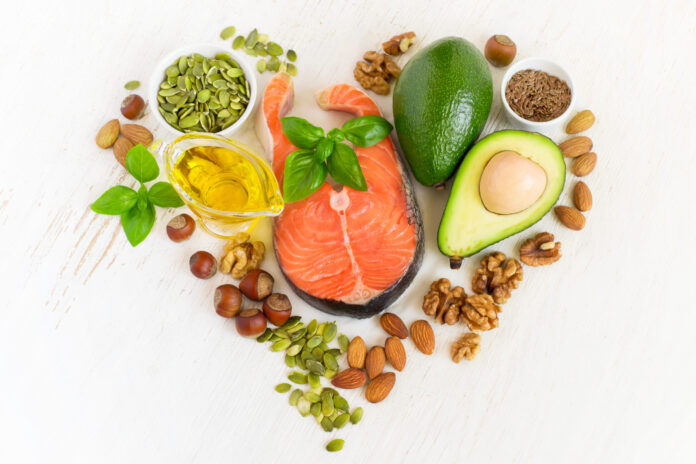Together’s nutrition guru, Liz Cassidy, proffers some not so fatuous dietary advice.
We’re all familiar with the concept of ‘lean cuisine’. Influencing our own home-cooking, its commercial manifestation appeared on supermarket shelves half a century ago as foodstuffs to help achieve an aesthetic or healthily svelte physique. But can a fixation with leanness obscure the nutritional and physiological benefits of our perceived perennial enemy, fat?
Energy, fat and filling out
If we consume too much fat, it may contribute to excessive calorie intake. Not rocket science. Gram for gram, fats contribute just over double the calories of either the protein or carbohydrate content of food. The body transforms any energy surplus, from lean or fatty foods, into stores including into fat tissue, generally the culprit in an expanding waistline.
Why your body needs fat
However, if a zero-fat body composition is your aspiration, think again. Body fat around our limbs and organs performs critical functions, among them shock absorption, insulation, and storage and transport of vitamins like A, D and E. Fats are in the packaging (“membrane”) of each and every cell. Fatty tissue secretes hormones involved in appetite regulation like leptin, so that we start to feel full when eating, preventing persistent hunger. With low fat tissue and body weight, oestrogen balance is potentially impacted. This can interfere with female reproduction by affecting menstruation and fertility.
Oil your brain cogs
Our cognitive powers rely heavily on fats, representing, as they do, over half of our brain mass. There’s a growing body of evidence that your grandmother was right – fish, but especially oily fish, is indeed ‘brain food’, as a rich source of the omega-3 fatty acid found in the highest abundance in our brains. That’s “DHA” (docasahexaenoic acid). Don’t skimp therefore on the occasional mackerel or sardine toast, salmon salad, rollmop, or anchovy pasta dish. You’ll be heeding developing science on minimizing your risk of cognitive decline. Be aware too that plant compared to marine sources yield much less DHA, though plentiful walnuts, chia, flaxseed and dark leaves can still boost your supply to some extent.
Healthy what – fat?
You can already spot that not all fats are equal. If you follow recommendations for a healthy heart and circulation, you’ll be aware that heavily processed fats, common in junk food, are a no-no, and that saturated fat, found in animal products like dairy and meat, should constitute less than 10% of your calories to help keep harmful cholesterol in check.
While going fat-free is not advisable, limiting overall fat consumption is not. Below 35% of your daily calories should be from fat. Use a food intake app, which will do the maths for you, or scrutinise food labels. Fat gives texture and taste, important for food enjoyment. Healthier fats are the way to go. Add unsaturated options like olive oil to salads, or munch on daily handfuls of hazelnuts, almonds, walnuts or pumpkin seeds.
Athletes may periodically follow low fat regimes to make weight, or just because accessing more of their calories from carbs will benefit an intensive training routine. For good health though, none of us should get less than a fifth of our energy from fat, since many vitamins and plant nutrients, such as beta-carotene in orangey-red veg, need fat to optimize absorption. In any case, you may notice persistent peckishness with little dietary fat. We absorb it slowly, so it prolongs satiety.
What about fat distribution and your health? Beware of accumulating too much weight around the middle to avoid visceral fat wrapped around your liver, heart or other organs. This increases risk for chronic disease such as coronary heart disease or diabetes. Women should aim for a waistline of below 80 cm and men, below 94 cm (90 cm for African Caribbean or South Asian ethnicities).
Lean, mean, fast machine
Perhaps you’re a dedicated gym-goer, with a routine to get ripped. Or maybe you hit the tarmac or pedals daily, chalking up the miles. Either way, you’ll know that body fat is a potential hindrance, interfering with definition or else with lightness and speed. There are indeed good reasons to aim for leanness with performance in mind, and for shifting fat mass via training favouring muscularity.
So, should we all target low body fat to the same degree? No. First, just to survive, we require an essential amount of fat tissue to support basic physiological functions like warmth, energy management, or hormonal signalling. This differs by gender, for men 2-5% of overall body mass and, for women, significantly more at 10-13%. Add to this the non-essential fat component and we might expect relatively fit males to have up to 17% overall and females, up to 24%. If you’re a successful athlete, training and competing regularly, knock off about 4% from these ceilings.
Of course, many of us may fall somewhat beyond the athletic or fit category, carrying substantially more fat. Note too that, as we age, muscle mass and strength decrease, accompanied by more fat deposition. All the more reason to stay active and include strength-oriented movement like weight training.
Fat to fuel your sport?
Ideally, no. Eaten just before your daily jog, fatty foods can cause indigestion or an unpleasant stitch in your side. Carbs are a better, more readily metabolized option. But, you might wonder, is it possible to increase your fat-burning potential? Possibly. Regular exercise may increase your ability to use fat while moving. The fittest people utilise the most fat when exercising, and lower intensity and longer training also enhance our reliance on it. So tune your sports routine if this is your goal.
In my genes
Finally, genes and fat metabolism? Gene variants may influence how you fare with different types of dietary fat, for instance predisposing you to increased obesity risk or slower weight loss with higher saturated fat intake. But on the upside, you may be lucky, with other variants helping you stay trim by switching in more monounsaturated fat – delectable olives, avocados or peanuts. So talk to a nutrition expert and gen up – your genes may amaze you!
If you would like further personalized advice contact Liz Cassidy (MSc, PGDip, DipCNELM). For more info contact Liz: emeraldaspire@outlook.com










